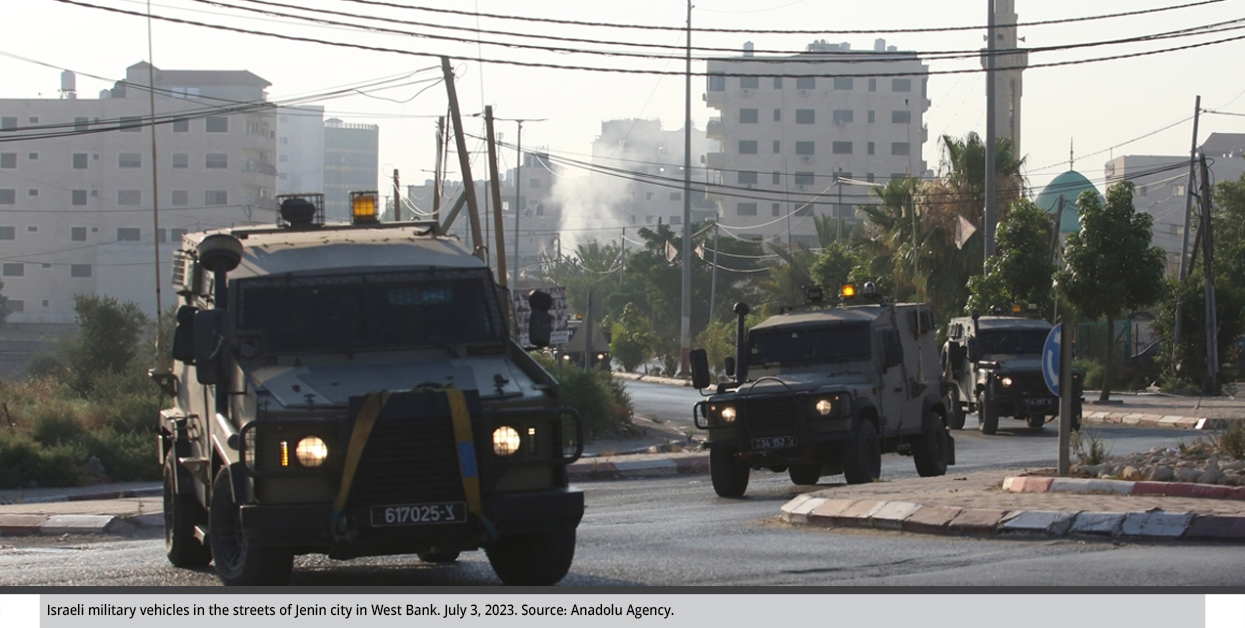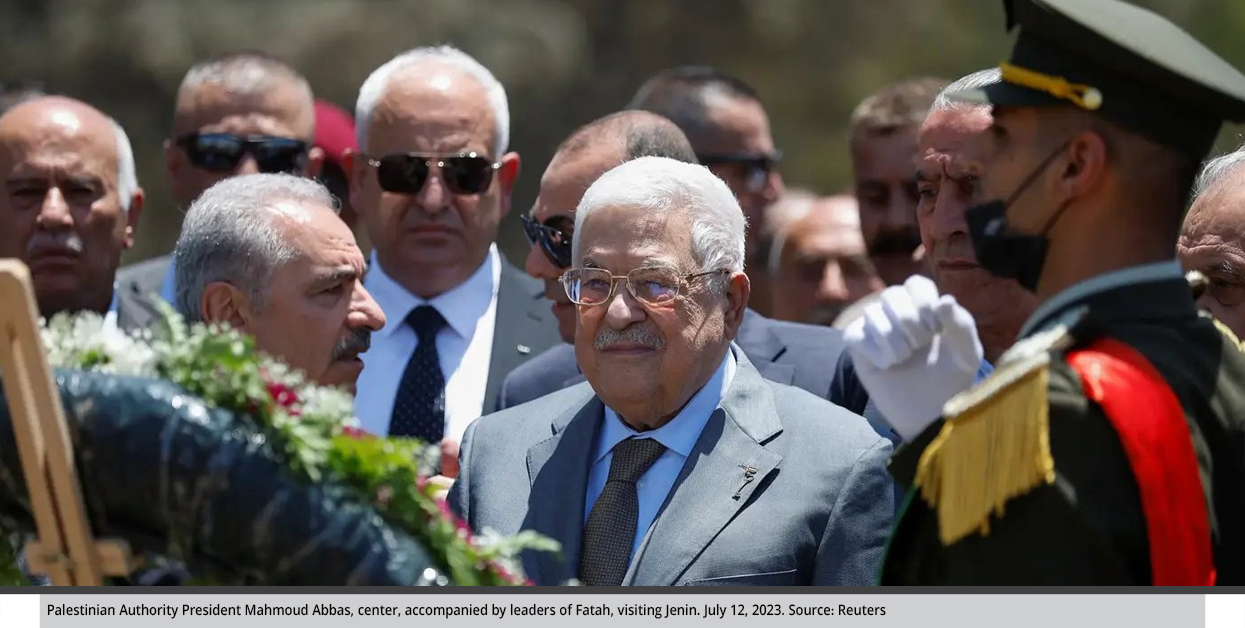What Comes after the Israeli Invasion of Jenin?
This assessment deals with the recent Israeli invasion of the West Bank City of Jenin, its refugee camp, and the circumstances accompanying the invasion. It also discusses the political and security dimensions behind it, delving into the features of strengthening the Palestinian Authority’ control over the northern West Bank.
by Hazem Salem Dmour
- Release Date – Jul 23, 2023

The Israeli invasion of the northern West Bank city of Jenin and its refugee camp on July 3 raises many questions about the political and security objectives at both the Palestinian and Israeli levels, and the expected outcomes of the invasion in the short and medium terms. These questions arise amid differing official viewpoints between Israel and the Palestinian Authority (PA) regarding the invasion. We also can’t dismiss the position of Hamas and Al-Jihad Al-Islami movements on both the political and field level.
Invasion Circumstances
The Israeli invasion of Jenin and its camp is due to a complex set of circumstances inside Israel and the West Bank. Israeli fears that Jenin will attract a concentration of Palestinian armed groups and become a base for launching military operations against its army and settlers in the West Bank. A rising chorus of Israeli voices also worry about the impotency of the Israeli deterrence force towards the armed groups, which successfully carried out shootings against the Israeli forces and settlers, especially in the northern West Bank. In addition, the Palestinian armed groups demonstrated new methods and tactics, both in their response to Israeli invasion and in carrying out the shooting attacks[1].
These events coincide with the increased power and influence of Hamas in the West Bank and the clear support Iran and Hezbollah offered the armed groups. This support includes training and the transfer of techniques for making improvised explosive devices and missiles. The West Bank is now clearly one of many arenas in which Tehran seeks to drain and surround Israel.

Hence, calls were loud inside Israel to neutralize the West Bank from any Israeli-Iranian escalation. Yet Tel Aviv’s inability to establish de-escalation in the West Bank was a factor in the escalation of violence there. This resulted in Israel and the United States demanding that the PA be given the opportunity to regain its control in the northern areas of the West Bank.
Political and Security Factors Behind the Invasion
The main dimension of Israel’s invasion of Jenin and its camp is Tel Aviv’s efforts to give the Palestinian Authority the opportunity to reestablish its security control over the northern West Bank, particularly in Jenin. The invasion helped facilitate security measures and created the necessary political and social conditions for the PA to conduct a security intervention in Jenin.
Despite the official and media divergence in their viewpoint, the perspectives of the PA and Israel meet at a pivotal point: ensuring that the security condition in the West Bank will not collapse, starting in Jenin and its camp.
In the complex and problematic Israeli perspective, the PA’s influence is receding in favor of the growing strength of Hamas and Al-Jihad Al-Islami in Jenin. This may portend the collapse of the security conditions in the West Bank in the medium term, which, according to the Israeli government, is unlikely to happen. However, at the same time, Israel is facing a dilemma of religious Zionist parties attempting to exert pressure to restrict the PA’s control in the West Bank.
On the other hand, the Palestinian perspective acknowledges the PA’s weakness and the decline of its security control in Jenin. Living in a complex situation, the PA cannot directly confront the armed groups in Jenin for many political, organizational, social, and even logistical reasons. However, the PA holds Israel responsible for all these complications.
Therefore, the two perspectives intersect in two ways. On the one hand, it paves the way for the first steps to restore the PA’s security control over Jenin and its camp. On the other hand, it gives Israeli Prime Minister Benjamin Netanyahu little room to maneuver in front of his far-right coalition partners to help the PA to survive and continue carrying out its security role. Both ways are under the pretext of preventing a collapse of the security conditions in the northern West Bank.
Enhancing the PA’s Control of the Northern West Bank
After the Israeli invasion of Jenin and its camp came to an end, features of enhancing the control of the Palestinian authority on northern West Bank started to be promptly realized. So far, the most significant features are:
First, on July 12, accompanied by a group of Fatah officials and leaders, Palestinian Authority President Mahmoud Abbas visited the city of Jenin and its camp. This unusual trip carried many symbolic and moral connotations regarding Abbas’s determination to impose the PA’s presence and restore its prestige in the area.

Second, the deployment of Palestinian security forces, especially the elite Palestinian National Security Forces, in Jenin city and its refugee camp. This deployment coincided with the Palestinian security forces’ arrests of armed operatives in the village of Jaba in the Jenin area on July 17.
Third, Palestinian officials released statements firmly warning against violating the law and confirming the determination of Palestinian security forces to impose order in Jenin. On July 17, the Palestinian Interior Ministry released a statement and Jenin Governor Akram Rajoub stated on July 12 that Abbas’s visit to Jenin and its camp was widely welcomed by all citizens, specifically in the Jenin camp. Rajoub added that the visit represented a clear message of the Palestinian Authority’s responsibility towards the people there.
Fourth, Fatah supported the PA’s position at the organizational, public, and military level through the Al-Aqsa Martyrs Brigades. This transition enhanced the position of the Palestinian Authority and the Palestinian security forces, giving them unofficial but important momentum by sending warning messages to Hamas and Al-Jihad Al-Islami in Jenin in particular and the West Bank in general.
Fifth, the Israeli forces did not carry out military or security operations in the Jenin area after the recent invasion.
So far, indications seem to favor the continuation of the PA, Palestinian security forces, and Fatah in restoring the Palestinian Authority’s control and imposing its security rule over the Jenin area. The PA then expanded its control to other areas in the West Bank, where Hamas and Al-Jihad Al-Islami militants are active, especially in the Tulkarm area and the Aqabat Jaber refugee camp located south of Ariha. The PA benefited from its success and that of the Palestinian security services in containing the phenomenon of the “Lions’ Den” armed movement in the Nablus area.
In the case of Nablus, the Palestinian Authority was able to contain the phenomenon of armed groups. It enhanced a firm security grip in the face of Hamas members and financiers, and convinced dozens of militants to surrender themselves to the Palestinian security forces, using soft methods, to protect them from the Israeli occupation forces. In addition, the PA employed Fatah and the Al-Aqsa Martyrs Brigades to support its policies and the policies of the Palestinian security forces organizationally, popularly, and in media. Having succeeded in this containment in the Nablus area, the PA’s chances of success were increased in other areas and the methods to do so were developed.
The Challenge of Dealing with Hamas and Al-Jihad Al-Islami Movements
Hamas and Al-Jihad Al-Islami both reject the PA’s recent measures in the Jenin area. However, this does not necessarily mean that their reasons for this rejection are identical or that the two movements coordinate their reactions to defeat these measures.
For its part, Hamas is constantly seeking to escalate the security conditions in the West Bank. It is expected that this quest will continue via military operations from time to time. Following the invasion of Jenin, Hamas will move to another level of media and popular escalation, pitting the West Bank’s Palestinian citizens against the PA and Palestinian security forces. This will lead to something resembling a popular uprising against the PA and its practices, especially in the event of the Palestinian security services’ intensifying procedures against Hamas operatives.
However, the case seems different for Al-Jihad Al-Islami, which will continue to develop its military capabilities and carry out qualitative operations, but without getting involved in clashes with the PA or its security services.
Finally, the Israeli invasion of Jenin and its camp is related to tacit understandings that give the PA control over Jenin and other areas in the West Bank. These understandings aim to establish calm and halt the Israeli provocations that led to the escalation of violence there. However, the future of the PA depends on a number of Israeli, regional, and international factors and variables that cannot be overlooked, no matter how much the PA adheres to some understandings. Some of the factors and variables include the following:
- The policies of the current Israeli government and its ability to find an exit from its internal crises, as well as the ability of Israeli President Isaac Herzog to contain the opposition of the Religious Zionist Party, a political coalition against any cooperation or coordination with the PA.
- The Jordanian and Egyptian positions, considering their central roles in the understandings of Aqaba and Sharm el-Sheikh[1], and the continued Jordanian and Egyptian pressures on the Israeli and Palestinian sides to make these understandings succeed. In this way, the collapse of the security conditions in the West Bank is prevented.
- The American position that rejects many of the policies of the Netanyahu government, and the possibility of developing that position into clearer and more assertive measures towards Israel and its government.
- The fragility of the Palestinian situation, where any exceptional security event—in the West Bank, inside Israel, or on its northern or eastern borders—can tip the scales and accelerate the collapse. Some examples of such security events are the success of Palestinian armed groups in launching missiles or booby-trapped drones from the West Bank and carrying out qualitative operations inside Israel. Another example is the increase of escalation on the northern border, especially in light of the continuing tension between Israel on the one hand, and Iran and its allies on the other.
[1] Strategiecs Think Tank - Aqaba and Sharm el-Sheikh Summits: Seeking Limited Achievements with Future Impact
[1] Strategiecs Think Tank - What does the Development of the Palestinian Armed Factions’ Capabilities Reflect?

Hazem Salem Dmour
General Manager / Specialized Researcher in International Relations and Strategic Studies
 العربية
العربية